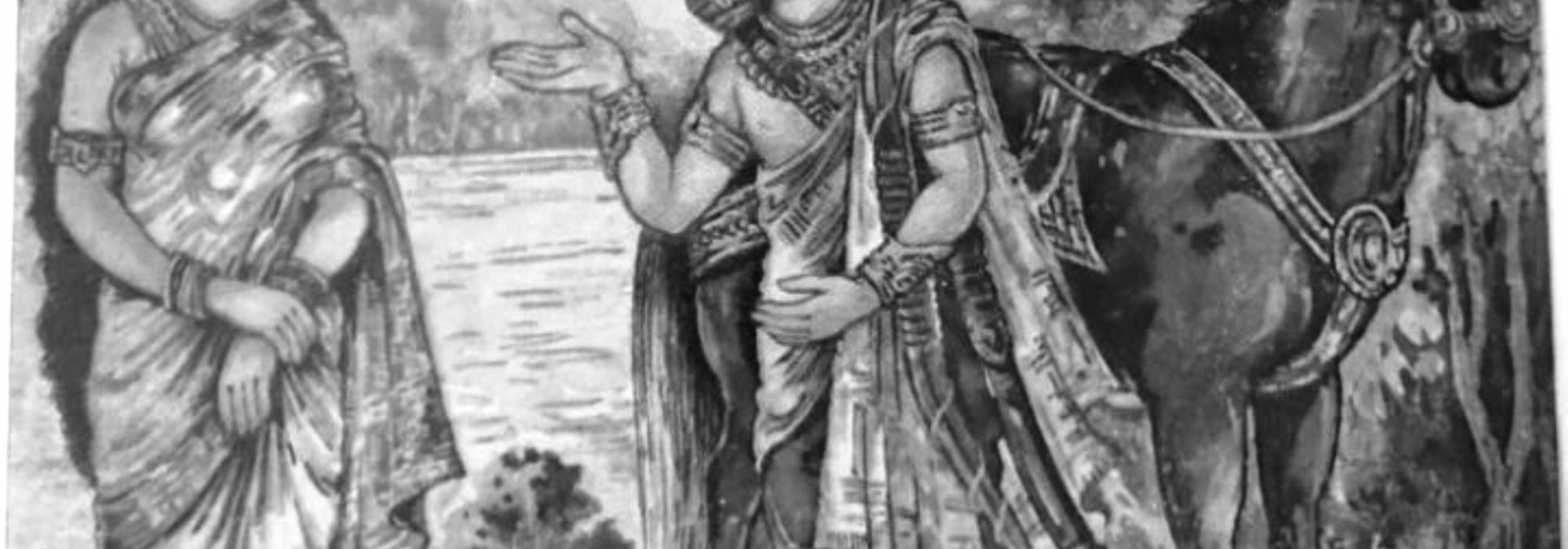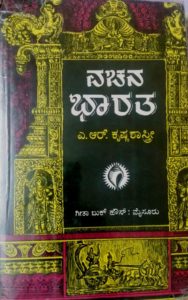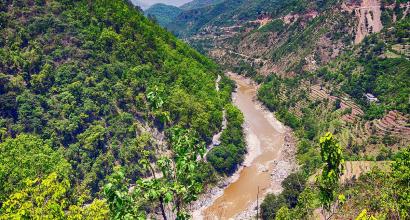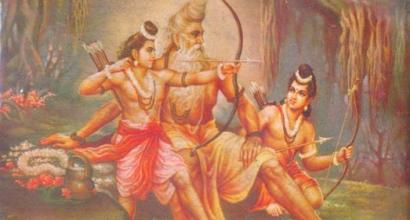This Vyāsa-pūrṇimā, Prekshaa is delighted to present a translation of the masterly introductory essay of A R Krishna Sastri to his magnum opus, the Vacana-bhārata, which is a condensed prose rendition of the Mahābhārata in modern Kannada. The first edition of the book came out in 1950. It was hailed as a great work by his contemporaries and has remained as the authentic source of Mahābhārata in simple Kannada prose.
D V Gundappa (DVG) once remarked: "Always clear and forcible and vivid and elevated, (Dr. Krishna Sastri's) style has here attained the best classical standard in chastity, in directness of appeal and in that tense dignity which is the distinguishing mark of the Mahabharata... Everything about the book is so fully appropriate... format, type, cover jacket, illustration on it... And (his) Notes and Appendices are characteristic – deep, searching, thorough, conclusive..." In another context, DVG hails Krishna Sastri's work as that of a mountain captured in a wonderful photograph; all the fine details of the landscape are authentically captured. Rāṣṭra-kavi M Govinda Pai, a national literary giant said about this work: "In one word, the Golden Book of Bharatha... It is an immortal work that bids fair to live as long as Kannada world..."
The present English translation by Arjun Bharadwaj and Hari Ravikumar will be published as a series. Although some of the information contained in this series is dated, it gives us an overview of the circumstances that motivated Krishna Sastri to compose such a succinct and powerful work. We hope that the historical context presented in the current part interest our readers. – Ed.
Vacana-bhārata – Introduction
नमस्सर्वविदे तस्मै
व्यासाय कविवेधसे ।
चक्रे पुण्यं सरस्वत्या
यो वर्षमिव भारतम् ॥
Salutations to the all-knowing one,
the Kavi-Brahma (poet-Creator) Vyāsa,
who sanctified the land of Bhārata
by the showers of the divine language!
(Bāṇabhaṭṭa, the poet of this verse, equates Vyāsa to the Creator Brahmā; just like the latter created bhārata-varṣa, the former created the Mahābhārata. Brahmā's consort is Sarasvatī, who is the deity of language; she also flows as the life-giving river Sarasvatī that purifies the land of India. Similarly, in her manifestation as the divine language, through Vyāsa's poetry, she sanctifies the Mahābhārata.)
The Mahābhārata is a voluminous work. Together with the Harivaṃśa it exceeds a hundred thousand verses. There is no work of this magnitude in world literature. If we put together the Greek epics, Iliad and Odyssey, they amount to an eighth of the size of the Mahābhārata. Just like India is home to the tallest mountain in the world, the Indian civilization has the grandest epic in the world, and we Indians can be justly proud of them; however, akin to the Himalayas, the Mahābhārata too has become difficult to scale for the common folk. Even those well-versed in Sanskrit will not find it easy to read the epic from cover to cover. This is perhaps the reason for the living tradition of oral re-tellings of the epic, which span months and years. This was a healthy pastime for people and even the illiterates would gain access to classical culture.
Gifted and devout poets like Kumaravyāsa (nom-de-plume of Nāraṇappa of Gadugu), out of their desire to share the joy of literature with the masses, creatively adapted the Mahābhārata into Kannada. The Karṇāṭa-bhārata-kathāmañjari of Nāraṇappa is one among the golden kalaśas that adorns the grand gopura of Kannada literature. However, it is in the form of verses; it is composed in Middle Kannada (ನಡುಗನ್ನಡ); the laity has neither the patience nor the skill of language to read it. And as for Pampa’s Vikramārjuna-vijaya, it is a campū-kāvya (a mix of prose and verse), complex in its language. One needs to have deep scholarship in order to savour it.
Seeing this predicament, Mummadi Krishnaraja Wadiyar [the king of the princely state of Mysore from 1799 to 1831] commissioned the original Sanskrit Mahābhārata to be translated word-for-word into Kannada. However, this work runs into many huge volumes and therefore is prohibitively expensive. And the copies of even these volumes are largely unavailable today; the few copies that might be found in bookstores or libraries are old and mutilated. Of late [c. 1950] the Late Devashikamani Alasingacharya, with great effort and courage, translated and published the Mahābhārata. [This was a prose translation of the original.] This has largely followed the Southern recension. The language is consistent, easy to follow, and contemporary. It has been made attractive by using illustrations at appropriate places. Since this work runs into several volumes, those who are interested merely in knowing the larger story of the epic will find it tedious to go through the entire translation.
In spite of this, even as the copies were printed they were sold out, thus indicating the popularity of the work. And due to this, it became increasingly difficult for a single person to possess all volumes of this translation. In the mean time, there were a few who recast this work into Kannada prose and brought out abridged versions in single volumes. However these abridged versions were overly concise and they were also peppered with the authors’ views and interpretations. There was a need for a single-volume, simple Kannada prose rendition of the Mahābhārata—true to the original and comprising finer details like sub-plots and aspects of ethics and dharma—accessible to the common reader. I had this opinion even as a student and when I became a teacher, I felt a greater need for this. And thus when a request came to undertake such a task, I wholeheartedly took to it. This work doesn’t contain any of my personal opinions. I strictly adhered to the original, fearing that if I were to use my intelligence and add flavour to the original, it would be as foolish as trying to add colours to the rainbow or to stitch clothes for a doll in a painting. My primarily problem was in deciding what portions of the original to omit in my rendition. I had to condense the entire epic into a book of around five hundred pages. It should be authentic but shouldn’t appear a collage of disjointed events.
If one has to compose an authentic rendering of the Mahābhārata, one has to be true to the Sanskrit original. Be as it may, there are several recensions of the text of which the Northern and the Southern variants are prominent. Both recensions have interpolations. So what is to be followed? Over the last hundred years, there have been several Indian and Western scholars who have dealt with this issue and tried to bring out a critical edition of the text. This Himalayan task was taken up under the able guidance of V S Sukthankar at the Bhandarkar Oriental Research Institute, Poona. So far the critical text until the Bhīṣma-parva has been published [c. 1950. The entire critical text was completed in 1966]. In the current work, Vacana-bhārata, I have relied on the critical text of V S Sukthankar. As for the section after the Bhīṣma-parva, I placed in front of me three texts—the Northern recension, Kṣemendra’s Bhārata-mañjarī, and the version printed in Kumbhakonam—and after excluding segments that I had strong reasons to believe were interpolations, I began using the rest for my work. It is clear that my work is not a word-for-word translation. If it had been so, wouldn’t it have run into several volumes? I have not, however, excluded a single line or simile that had aesthetic appeal. I’ve condensed the content in a few places while I have wholly left out large chunks like the Anu-gītā, Sanatsujātīya, Kaliṅga-nīti, and the Nārāyaṇīya. In my work, I have ensured that there is no redundancy, which is rather common in the original. At the end of his Bhārata-mañjarī, Kṣemendra writes:
मद्वचोदर्पणतले
महाभारतदिग्द्विपः ।
समस्तावयवोप्येष
मुष्टिमेय इवेक्ष्यते ॥
‘Just like seeing a diggaja (mythical elephant guarding the directions) in a mirror and yet capturing its image with every fine detail, I have compacted the Mahābhārata in my work.’
I am, however, not as capable as this great poet. My intention is also not to summarize every small segment of the great epic. My work is like that of severing the roots, leaves, and nodes of a sugarcane; peeling off its bark; removing the straw-like portions; chopping the remnants into edible chunks; and putting it in a bowl for everyone to savour. It is like peeling an orange, separating the slices, removing the seeds, extracting the juicy segments, and serving them on a silver plate. Well, such is my intent. To what extent I have been successful is for the readers to decide.
The Upakramaṇikā (Prologue) Section of the Mahābhārata
In the current work, I start the narration of the epic from the story of King Śantanu (in the Critical Text, it starts from 1.92.24). Śantanu’s son is Bhīṣma. Dhṛtarāṣṭra and Pāṇḍu are his brothers’ children and the Kauravas and Pāṇḍavas are their children. The main theme of the Mahābhārata is as follows: the Pāṇḍavas lose their kingdom to the Kauravas due to their mutual animosity, a Great War ensues between the cousins, and the result is the ‘Jaya’ (victory) of the Pāṇḍavas. Thus I felt that it would suffice to start the narration from the story of their great-grandfather Śantanu. If we were to trace the ancestry of this line, it would go all the way back to Brahmā, the Creator. That is what we find in the original. A question arises as to what the first 91 adhyāyas (chapters) and the first 23 verses of the 92nd adhyāya contain. The following is an intimate introduction.
Adhyāya 1. Anukramaṇikā
नारायणं नमस्कृत्य
नरञ्चैव नरोत्तमम् ।
देवीं सरस्वतीं व्यासं
ततो जयमुदीरयेत् ॥
Having saluted Nārāyaṇa,
the human and the divine;
Sarasvatī; and Vyāsa –
May Jaya be hailed!
This is the benedictory verse that occurs at the very beginning of the Mahābhārata. The anukramaṇikā (prologue) of the first chapter begins with this. The Sūta-paurāṇika (mythologist-bard) Ugraśrava, son of Lomaharṣa comes to Naimiṣāraṇya (Naimiṣa-forest) where the kulapati (head of the sages) Śaunaka is conducting a twelve-year long satra (a type of yāga, a Vedic fire ritual). Śaunaka and the other seers received him, exchanged pleasantries, and extended hospitality. After Ugraśrava rested awhile, the seers requested him to narrate a few stories. (Verses 1-7) He started his narration by saying that he had visited the sarpa-yāga of King Janamejaya, where the seer Vaiṣampāyana retold the story that he had heard from Vyāsa. After hearing these stories, Ugraśrava went on a pilgrimage to various holy sites and also walked across the regions (Samanta-pañcaka) where Kauravas and Pāṇḍavas fought the war. Then Ugraśrava asked the seers as to which story they would like to hear. They desired to listen to that sacred story of Bhārata that contained the essence of the Vedas. He begins narrating the Mahābhārata story with the following invocatory verses:
आद्यं पुरुषमीशानं
पुरुहूतं पुरुष्टुतम् |
ऋतमेकाक्षरं ब्रह्म
व्यक्ताव्यक्तं सनातनम् |२०|
Salutations to the primordial being Īśāna, who is invited and invoked frequently in yajñas; and often worshipped by many; he is the One, the Cosmic Order, the imperishable, the eternal Brahman who manifests in both perceptible and imperceptible forms.
असच्च सच्चैव च यद्-
विश्वं सदसतः परम् |
परावराणां स्रष्टारं
पुराणं परमव्ययम् |२१|
He is Existence yet he transcends existence and is the master of the defined and the un-defined; he is the Creator of the superior and the inferior; he is ancient yet ever-new; he is the Supreme and he is indestructible.
माङ्गल्यं मङ्गलं विष्णुं
वरेण्यमनघं शुचिम् |
नमस्कृत्य हृषीकेशं
चराचरगुरुं हरिम् |२२|
He is Viṣṇu, the Auspicious and the all-pervading; he is radiant, unblemished, and pure; I salute Hṛṣīkeśa, the master of the senses and a manifestation of Hari, the Overseer of the animate and the inanimate.
महर्षेः पूजितस्येह
सर्वलोके महात्मनः |
प्रवक्ष्यामि मतं कृत्स्नं
व्यासस्यामिततेजसः |२३|
I narrate to you, in its entirety, the noble words of the great seer-poet Vyāsa, of infinite brilliance, worshipped by the world.
Ugraśrava’s narration and dialogue with the others goes on until the end of adhyāya 54. From then on, Vaiṣampāyana’s words begin. After he narrates the entire story of the Mahābhārata, we find the concluding remarks of Ugraśrava.
We learn from this adhyāya what follows later. In the beginning there was no light; it was only darkness. There was only Brahmā—in the form of an egg—the seed of all creation. And from that, the process of creation started. Deities and humans were born. Several royal lineages arose.
Some people trace the origin of Mahābhārata to Manu, to Āstika, or to Uparicara. After Vyāsa re-organized the Vedas, he started composing this sacred epic. He ordered Vaiṣampāyana to narrate the epic when Janamejaya asks. If we omit the upākhyānas (sub-plots) it comes to 24,000 verses of thirty-two letters each (prose or verse, not necessarily adhering to theśloka format). There is also an abridged version in 150 verses. Vyāsa first told this story to his son Śuka. Then the rest of the students learnt it. Śuka taught this to Nārada and others.
This is followed by the summary of the Mahābhārata. They have described Duryodhana and Yudhiṣṭira as two giant trees representing Anger and Dharma respectively. This summarized story begins at the point where Pāṇḍu has annexed several territories, thanks to his valour, and is ruling his empire. The story concludes at the point where Dhṛtarāṣṭra is lamenting at the loss of his children and repenting for his acts, with Sañjaya consoling him. The adhyāya ends with the semantic etymology of the word ‘mahābhārata’ – महत्वात् भारवत्वाच्च महाभारतमुच्यते – “It is known as Mahābhārata for its profundity and its great volume.”
To be continued.
Thanks to Śatāvadhāni Dr. R Ganesh for being the motivation behind undertaking this translation and for his astute feedback.













































